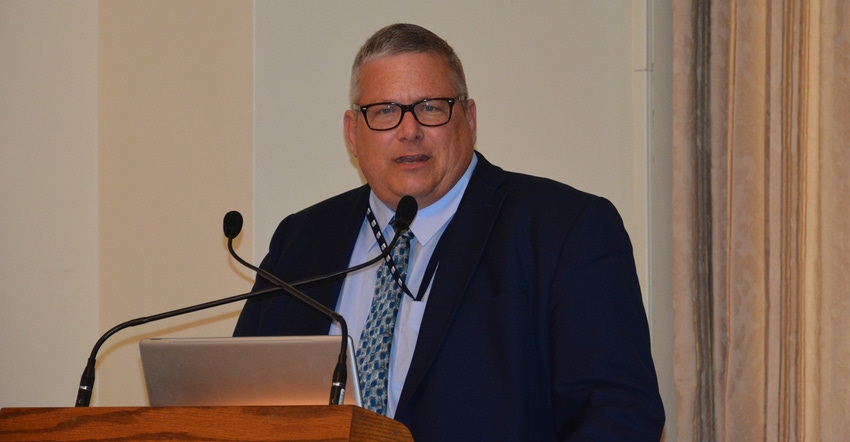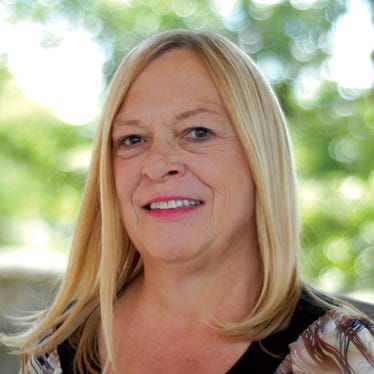
Bill Northey, USDA undersecretary for farm production and conservation, said that getting help to dairy farmers in the form of having the program authorized in the 2018 Farm Bill rolled out as quickly as possible is the top priority for the department for going forward.
Speaking to the North American Agricultural Journalists at their annual meeting in Washington, D.C., Northey said the department is well aware of the crisis in dairy and is pushing to have the program ready for farmer sign-up by early June.
He added that payments in the program will be retroactive to Jan. 1, something that gives hard-hit dairy farmers the prospect of a healthy payment in short order after sign-up.
Moving on to other hot topics in the agriculture sector today, Northey addressed the reorganization of USDA agencies — including moving some out into the countryside; legalization of hemp production authorized in the 2018 Farm Bill; and disaster aid to Midwestern farmers hit hard by a mid-March flooding event that destroyed hundreds of miles of highway, caused bins of stored grain to rupture, and damaged bridges, dams and other infrastructure.
Talking hemp
Northey acknowledged that the appetite of farmers to get into the hemp growing business is immense. He said that North Carolina and Kentucky, both of which had major hemp production in the past, are anxious to get back into the business.
Hemp, a cousin to marijuana, was banned as part of the war on drugs but has many uses in the production of fiber products such as rope and paper, with a far more environmentally friendly platform than current sources such as wood pulp or petroleum.
It is also the source of cannabidiol oils, which do not contain THC, the intoxicating ingredient in marijuana, but have been shown to have high value in treating medical conditions such as seizures and chronic pain without the side effects that render many other drug treatments undesirable.
Northey said that tough economic times have farmers looking for more ways to make money, which has fueled a rising interest in hemp.
But he cautioned journalists that it would be a good idea to caution farmers that finding a market for their crop is important because the market structure is not well defined at this point.
“Right now, my advice would be to know before you grow it where you are going to sell it or treat it as an experiment,” he told the NAAJ group. “I think there’s a good chance it could be profitable, but it is going to take the market a period of time to ramp up.”
Reorganization of USDA
Agriculture Secretary Sonny Perdue, in an effort to make USDA more responsive to the people it serves, has a plan to reorganize USDA and combine several agencies so they are in physical proximity.
The plan, nicknamed F-PACK, is a plan to coordinate information between agencies so they all have the same information on the same farmer.
The reorganization would put the Farm Service Agency, Natural Resources Conservation Service and Information Technology under one umbrella, allowing a farmer who qualified for help from one agency to immediately access other agencies who might help with the same project.
Northey said one of the obstacles the department faces as it attempts the restructuring is a lack of staff in place to handle all the work.
Northey said there are “pockets” within USDA that are still not fully staffed more than halfway through the Trump administration’s first term, partly because of unfilled positions and partly because of deliberate cuts to staffing.
He said Perdue wants the new plan to be a “simple, easy to deliver, one-touch system” that allows for farmers to easily access programs.
“We are looking at the time sinks, places where a lot of streamlining can take place without an impact on farmers who use the system,” he said.
Dealing with disaster
While much of the loss from the March “bomb cyclone” will be covered through insurance or aid programs in place in the farm bill, one major loss will not. The value of stored grain is not part of the indemnity coverage that helps farmers replace infrastructure such as the bins themselves or farm equipment and buildings.
The event occurred at the worst possible time — in early spring of a year that had seen record amounts of grain held in storage on farms and in terminal elevators, many of the them located on the Missouri or Mississippi Rivers for ease of loading barges for river transportation if the gridlock created by trade disputes was eased.
It was immediately followed by a mid-April severe weather event that brought more heavy snow and rain and high winds over much of the same territory affected by the first event. That hadn’t even happened yet when Northey delivered his remarks.
Market Facilitation Program
Farmers have until May 1 to sign up for payments to help them withstand the losses created by trade disruption from the cancellation of agreements and the imposition of tariffs.
Northey said he believes that there are mechanisms in place to help cotton farmers who will not have ginning reports by May 1 to use an alternate method of estimating production to sign up for the program.
He said some payment limits have already been hit but that in most cases, aid is still available.
To be eligible for help, farmers must have an adjusted gross income of less than $900,000. The amount of payment was calculated based on estimates of how much individual crops were affected by trade disruption. For example, much less corn is exported than soybeans. Sweet cherries and almonds were added after the program rolled out.
The bottom line, Northey said, is that “we just need to get back to trading.”
Northey said that he views the recent talks between U.S. and Chinese trade representatives as positive and that the message for Chinese buyers of American products is “you have a green light to buy.”
Northey said that he has made several trips to China in both state and federal jobs and that it is his perception that to President Xi, ag trading is like the ballast of a ship — it is the one thing that is safe.
“I hope that the initial purchase agreements are floors, not ceilings,” he said.
About the Author(s)
You May Also Like






